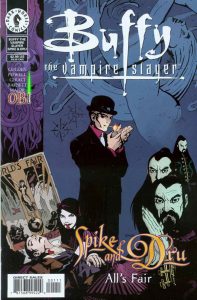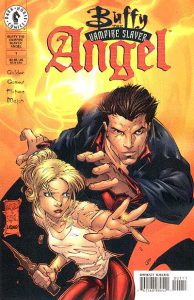Angel’s first “solo” adventure actually came out a few months before his debut as a TV leading man. Although later collected in a trade paperback with the familiar “Angel” logo, the three-issue “Angel: The Hollower” (May-July 1999) debuted under the “Buffy” banner and is set in Season 2, so it’s technically a “Buffy” yarn.
Writer Christopher Golden, assisted by “BTVS Classic” regulars Hector Gomez (pencils) and Sandu Florea (inks), follows a soon-to-be-familiar structure where something from Angel’s past emerges in the present. In this case, it’s the titular Hollower, a tentacled beast that burrows up from the ground and sucks the demon essences out of vampires. (The Season 7 phrase “From beneath you, it devours” comes to mind.) But Buffy also has a reason to fight the Hollower: Once it’s full, the beast regurgitates those demon essences, which then inhabit humans, turning them into vampires.
“The Hollower” reminds me that during his time on “Buffy,” Angel is the man in the shadows. So when an old wound from his past resurfaces – see also “Amends” (3.10) – he’s not likely to seek out Giles’ and Buffy’s help. That’s the theme of the story, which shows Angel, Spike, Drusilla and Catherine taking on the Hollower in the 19th century. Not familiar with Catherine? That might be a tip-off that she’s not gonna survive this new showdown; she might as well be wearing a red shirt.
The story fits nicely into Season 2 except that Buffy references her current modeling stint from “BTVS Classic,” which I had thought takes place in Season 3. The letters page in the back of “The Hollower” Issue 1 – in response to my letter, in fact – says the early issues of “BTVS Classic” take place in Season 2.
That doesn’t seem to jibe, though, since in those comics Good Angel and Oz are both in the group. In “Surprise” (2.13), Oz first learns about the existence of vampires at Buffy’s birthday party, then Angel turns evil later in the episode. Season 3, though, has a small window – between “Revelations” (3.7) and “Lovers Walk” (3.8) — where Angel and Oz are in the group and Cordy and Xander are still a couple. There’s no ideal placement for the early Dark Horse comics, but they simply can’t take place in Season 2 (even though they have a Season 2 feel).

Spike, Dru and Angelus are in fine form in “The Hollower,” throwing a shindig where they drain their guests then party on with corpses strewn about in Issue 2. But the three “Spike & Dru” one-shots (April and October 1999 and December 2000) are even better showcases for the black humor that comes from vampires who have all the relationship dramas of humans but matter-of-factly hunt and drain people of their blood the way we would go out for dinner.
Golden is assisted by James Marsters on the first issue, “Paint the Town Red,” and goes solo on the next two, getting more comfortable with the challenging speech rhythms of Drusilla as he goes along – although a lot of her statements are variations on the stars singing, or something in that vein. Spike and Dru’s banter sounds right, but there aren’t any specifics that stuck in my head.
The unconnected stories go in reverse chronological order. Issue 1 takes place after Spike and Dru flee Sunnydale at the end of Season 2. Spike rules a small European town via fear, something that seems unlikely for a modern tale, but I’ll allow it. He throws Dru out a window into the daylight in annoyance, burning her, and this seems like the catalyst for their breakup (which we learn of in “Lovers Walk”). But he ends up saving her: He feeds blood to the weak Dru like a mother bird feeds its young. This is the grossest and darkest of the three issues.
Issue 2, “The Queen of Hearts,” finds the vamp lovebirds driving cross country en route to their first Sunnydale visit in early Season 2. They stop in St. Louis to do some riverboat gambling, and we as readers can appreciate being in on the joke: The demon who runs the riverboat has no idea who he is up against, but we do.
Issue 3, “All’s Fair,” seems lighter than the other two, but it’s not because of the story, but because the team of Eric Powell (pencils) and Drew Geraci and Keith Barnett (inks) take over for Ryan Sook. As I mentioned in my review of the Season 2 Angelus joint “Ring of Fire,” Sook doesn’t nail likenesses (although we always know who is who). But he nails the mood of “Buffy” stories involving Angelus, Spike and Dru, emphasizing the gleeful ugliness of the vampires (there’s much more blood on their chops than you’d see on TV) and their killing grounds, which are filled with once-grand structures gone to ruin.
Powell and his inkers are comparatively “normal” artists, but “All’s Fair” is still a fun yarn, even without Angel or the Scoobies. I like the vibe of exciting possibilities afforded by the 1933 World’s Fair in Chicago, and Golden nicely ties in Spike’s killing of the Chinese Slayer, Xin Rong, in 1900 — shown in “Fool For Love” (5.7), which aired not long before this issue hit shelves – as that Slayer’s relatives track down Spike at the fair.
Although Golden never wrote an episode of the TV series, his work on these six issues remind me that he was a trendsetter of the types of Angel, Spike and Dru stories that tap into their grand history as fearsome vampires who delight in their evilness. He would soon take a crack at this “Buffy” subgenre in book form with 2001’s “Spike & Dru: Pretty Maids All in a Row.”
“Angel: The Hollower”: 3.5 stars
“Spike & Dru”: 4 stars
Click here for an index of all of John’s “Buffy” and “Angel” reviews.


